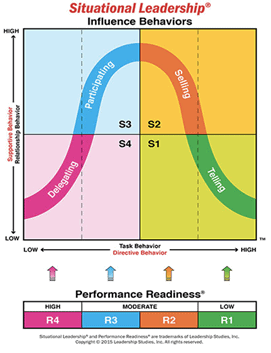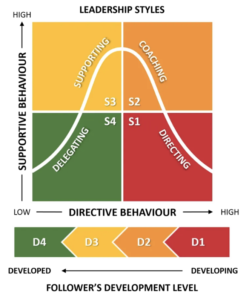What is Situational Leadership?
Situational leadership takes into account that people behave differently depending on the context they are in. More than that, situational models of leadership suggest that the best leaders do this intentionally – they change their leadership style depending on the group they are leading. For example, when on-boarding a new employee managers might start with a task-oriented, directive leadership style. For other employees (i.e., high performers who have been with the organization for years), the same manager may choose to provide more autonomy and delegate rather than direct. This is beneficial for a variety of reasons; evidence suggests that situational leadership can:[i]
- Improve performance
- Boost motivation
- Strengthen collaboration
- Create a culture of adaptability
In this blog we’ll dive into the history of situational leadership and explore different leadership styles and leadership assessments.
History of Situational Leadership
The first situational leadership theory was developed by Hersey and Blanchard (1969)[ii], and was called the Life Cycle Theory of Leadership. Throughout this life cycle of leadership, Hersey and Blanchard suggest that a leader’s focus varies from high task and low consideration, to both high, to high consideration and low task, to both low. Here, ‘task’ refers to the objective/practical elements of work, while ‘consideration’ refers to the social/relational components.
Although Hersey and Blanchard developed the Life Cycle Theory of Leadership together, in 1977 they decided to go separate ways. As a result, the Life Cycle Theory of Leadership was split into two slightly different models (see Figure 1).[iii]


Figure 1. Hersey’s version of The Situational Leadership Model (Left) versus Blanchard’s version of Situational Leadership II (Right).
The main difference between Hersey’s Situational Leadership Model (SLM) and Blanchard’s Situational Leadership II (SLII), is that Hersey uses the terms “Participating,” “Selling,” and “Telling,” while Blanchard uses “Supporting,” “Coaching,” and “Directing.” Hersey also refers to group maturity as “Performance Readiness” (ranging from R1-R4) while Blanchard refers to it as “Development Level” (ranging from D1-D4). Let’s take a look at each of these styles as we walk through the leadership model below.
Situational Leadership Styles
Unlike other leadership models, situational leadership does not categorize individuals as a certain type of leader. Instead, the same person might use multiple leadership styles, depending on the situation they are in. This situation is determined by the follower’s “performance readiness” (or “development level,” according to Blanchard’s version). Performance readiness can be broken down into task and psychological readiness:
- Task Readiness refers to followers’ ability to work
- Psychological Readiness refers to followers’ willingness to work (i.e., motivation, taking initiative, accepting responsibility for their actions, etc.)
Based on a follower’s readiness to work, leaders may adopt any combination of directive vs. supportive behavior (see axes on Figure 1). Directive behavior is task-oriented and concerned with getting the job done, while supportive behavior is relationship-oriented and concerned with an individual’s wellbeing. Along these two axes, situational leadership tends to fall along 4 distinct leadership styles:
- Telling (Directing) – This leadership style is high on directive and low on supportive behavior. It is ideal for new employees who do not yet know what needs to be done, or for employees who lack internal motivation and need to be told what to do in order to get it done.
- Selling (Coaching) – This leadership style is high on directive and high on supportive behavior. It is ideal for employees who are slightly more mature, still need to be told what to do, but are also ready to receive relational coaching and other personal/professional development.
- Participating (Supporting) – This leadership style is low on directive and high on supportive behavior. This style works best for employees who know the ropes, and understand what they need to do, but still require some relational guidance in order to stay motivated and engaged to do that work.
- Delegating – This leadership style is low on directive and supportive behavior. It works best for employees who are tenured, highly motivated, and top performers. They have a strong sense of ownership over their own work, and the success of the organization at large, which is why they can be given autonomy and require little task or relational support.
Situational Leadership Assessments
Now that we understand situational leadership let’s take a moment to talk about situational leadership assessments. Although situational leadership is voluntary (i.e., leaders choose which style to adopt based on the situation they are in), most people tend towards some styles more than others. A situational leadership assessment can be used to identify which situational leadership style(s) an individual naturally prefers. Knowing this, leaders become more able to use different leadership styles, because they understand when they can play to their strengths and when they need to add a little more effort to adapt their style to suit the group’s needs.
In terms of situational leadership assessments you can use with your team, it is interesting that neither The Center for Leadership Studies (based on Hersey’s model) or the The Ken Blanchard Companies (based on Blanchard’s model) offer a validated leadership assessment. They do, however, provide situational leadership training, which likely includes an assessment along the way. In addition to the flagship carriers of the situational leadership model, there are many tests and quizzes available online that claim to identify your situational leadership style. Whether or not these assessments have all been scientifically developed is not clear, but many of them are likely not valid or reliable enough to use for official hiring, selection, or development purposes. So what can organizations who are looking to develop situational leaders do instead?
Our Recommendation: Use a General Leadership Assessment
Rather than using an assessment that claims to be specific to situational leadership, we recommend using a general leadership assessment that tests a comprehensive set of leadership competencies. Based on the strengths and development opportunities outlined in that assessment, individuals will be able to infer which situational leadership style may come more naturally to them than others. Often, we can do this intuitively, however, it can be valuable to have an assessment confirm our instincts and/or point out our blind spots.
Another benefit to using a generic leadership assessment rather than one that is situational-leadership specific, is that it allows leaders to have a more variable set of strengths and preferences, rather than just those that can be grouped into a particular leadership styles’ bucket. For example, you may have a manager who is excellent at delegating and organizing the work of others, but who is also very socially astute and enjoys coaching and developing others. Under the situational leadership model, these qualities would fall under two different (and opposing) styles, which makes it more difficult to understand and appreciate personalities that fall outside of the box. Therefore, using a competency-based leadership assessment not only provides more flexibility, it also offers a more authentic snapshot of a leader’s real strengths and development opportunities.
Introducing the LSP-R
If you’re looking to find a valid competency-based leadership assessment for your team, check out SIGMA’s Leadership Skills Profile – Revised (LSP-R). The LSP-R is an assessment of leadership skills that can be used to guide leadership development efforts. The test scores individuals on 50 leadership competencies including cognitive, personal, interpersonal, and senior leadership skills. Everyone who takes the LSP-R will automatically receive a Focus Report which includes a summary of scores and analysis of results, as well as templates and activities for creating a personalized development plan.
Looking for More?
If you have questions about the LSP-R or how it can be combined with situational leadership, please don’t hesitate to reach out to us! Over the last 50 years we’ve worked with more than 8,500 private and public organizations across North America. We’ve got lots of tips and tricks to share, and our consultants are always happy to chat.

Erica Sutherland, Ph.D.
SENIOR CONSULTANT & EXECUTIVE COACH
Erica completed her Ph.D. in Industrial-Organizational psychology at Western University. She is a Senior Consultant at SIGMA, where she delivers consulting services and Succession Planning solutions to clients. As a member of SIGMA’s executive coaching team, Erica works one-on-one with leaders to develop talent. She also brings her expertise in measurement and psychometrics to the R&D team, assisting with the development and validation of SIGMA’s many assessments.

Brittney Anderson, Ph.D.
LEADERSHIP CONSULTANT & EXECUTIVE COACH
Brittney is a member of our coaching and consulting team. She brings her expertise in evidence-based practice to provide companies with leadership solutions that meet their needs. Primarily, Brittney helps her clients prepare for their future with succession planning and comprehensive leadership development programs. As an executive coach, she helps leaders hone their skills using a process-based approach to development.

Glen Harrison
VICE PRESIDENT
Glen oversees SIGMA’s sales and marketing activities. As a skilled presenter and trainer, he has designed and delivered engaging and entertaining workshops and webinars to help leaders and HR professionals enhance their understanding of how our products and services can be used to realize potential within their organizations.
.
[i] IMD. (2022). 15 Reasons Why Situational Leadership Ensures Business Success. IMD. Retrieved from https://www.imd.org/imd-reflections/reflection-page/situational-leadership/#:~:text=Combined%20with%20the%20use%20of,situation%2C%20no%20matter%20how%20complex.
[ii] Hersey, P. and Blanchard, K.H. (1969). Life cycle theory of leadership. Training & Development Journal.
[iii] B2U. (2022). Hersey and Blanchard Situational Leadership Model: Adapting the Leadership Style to the Follower. B2U. Retrieved from https://www.business-to-you.com/hersey-blanchard-situational-leadership-model/.